Highlights
- The SG flexible tool has been developed, which is a combination of a sol–gel polishing pad and a multilayer fiber pad.
- The microscopic yielding and the macroscopic yielding are the main properties of SG flexible tools.
- The problem of polishing complex curved surface by robot has been solved effectively by SG flexible tools.
- Complex marble surfaces with high gloss, low roughness and good surface consistency can be achieved by using SG flexible tools to polish.
Abstract
Newly developed Sol–gel (SG) flexible tools are used to polish complex marble surfaces with a robot to achieve a high-gloss, low-roughness, and scratch-free surface. The SG tool is composed of semi-solid abrasive and flexible fiber pads, which can realize a dual yielding effect at both the micro and macro levels so that the SG flexible tool can better fit the complex curved surface. Through the simulation analysis of the contact of SG flexible tools, the relationship between different curvature surfaces and polishing forces was obtained. Based on the Preston material removal theory, constant-pressure polishing of surfaces of different curvatures was achieved by simulating the contact force distribution between the SG flexible tool and the marble surface, as well as the constant-pressure material removal profile. By optimizing the space of the polishing trajectory, the uniformity of the material removal depth was improved, and the consistency of surface quality after polishing was enhanced. By establishing a model that correlates the optimum polishing trajectory space with curvature for surfaces of different curvatures, the effective prediction of material removal profiles for robotic polishing of surfaces of different curvatures was achieved. These strategies aim to ensure surface consistency after polishing complex curved surfaces under different conditions, thereby increasing the product’s added value. This research provides initial theoretical guidance for the application of SG flexible tools in the robotic polishing of marble with complex curved surfaces.
1. Introduction
The surface gloss of marble products with a complex shape determines the value of the product. Polishing is the most critical phase in shaping the surface gloss of marble [1], and the cost of polishing accounts for more than 40% of the total product cost. Optimizing the polishing process will help to improve the final quality of the product, increase economic value, and minimize costs, and it has a significant impact on the value of all other pre-polishing processes [2,3,4,5]. In the production of marble products with complex shapes, the grinding and polishing processes determine the gloss effect of the finished surface.
At present, manual and semi-automatic processes are the main methods used to process marble products with complex shapes. Manual polishing not only poses significant health risks to workers but is also associated with the potential for respiratory and musculoskeletal disorders [6]. With the continuous improvement of technology and the rapid development of the stone processing industry, traditional processing methods are facing many challenges and cannot meet future demands. Consequently, automatic polishing solutions for marble products with complex shapes are urgently needed.
Polishing is the continuous grinding of the marble’s surface with progressively finer abrasives. In this process, the abrasives remove scratches left by the previous steps and introduce finer scratches [3,7,8,9,10]. In the field of flat marble polishing, a mature research and industrialization system has been successfully established, and automatic grinding and polishing have been achieved. The polishing of marble with regularly complex curved surfaces has been extensively studied by scientists, and automatic grinding and polishing processes have been successfully realized. Both mainly use resin-bonded abrasive tools [11,12]. However, compared to flat and regularly shaped marbles, marbles with complex curved surfaces, characterized by intricate double-yielding effects and variable surface curvatures, still heavily rely on manual polishing. It is inefficient and will result in inconsistent surface gloss. Until now, there has been no solution for the automatic polishing of marble with complex curved surfaces. Recently, robotic polishing has attracted the interest of researchers and companies [13]. Robotic polishing systems provide an effective and economical solution for polishing complex curved surfaces and can be applied to process differently shaped workpieces [14]. But the robotic polishing of complex curved surfaces requires a more flexible fit between the polishing tool and the marble with a complex curved surface.
The central focus of flexible automatic polishing technology is to achieve efficient, high-quality, and stable polishing surfaces by polishing with compliant contact and using automation technology to control the polishing contact force to stabilize the process [4,15,16,17]. This technology includes active flexible control and passive floating flexible control. In the former, the sensor is used for information feedback and control, allowing the system to actively adapt to changes in the workpiece surface. The control system is complex and more difficult to control. In contrast, the latter integrates floating force control technology with flexible polishing tools, allowing the tools to passively adapt to changes in the workpiece. In the latter, polishing position and force are controlled separately, and the overall processing control is simplified. Compared to active flexible control, passive floating flexible control is easier to implement and more cost-effective, so it is widely used in the grinding and polishing of workpieces with complex shapes. Therefore, this paper uses the passive floating flexible control method combined with robots to achieve flexible polishing of marble with complex curved surfaces.
Research on robotic flexible polishing mainly involves controlling the polishing force, modeling and predicting the depth of material removal, and optimizing polishing trajectory space. The polishing force between the polishing tool and the surface to be machined is affected by a number of factors during polishing, including the curvature of the surface, the polishing force applied to the surface, and changes in the posture of the polishing tool [18]. The key to high-quality polishing is to ensure a consistent depth of material removal across the polished surface, which requires the precise control of the polishing force and polishing trajectory space to improve surface roughness [19,20,21,22], but this is challenging for complex curved surfaces [23,24,25]. To improve cost-effectiveness and improve process quality, researchers have conducted extensive research into the robotic flexible polishing of complex curved surfaces, focusing on flexible polishing. For example, Xie Liujie constructed a contact model between a flexible polishing disk and a surface using mechanical simulation software and established a material removal model by analyzing the contact states of different parameters [26,27]. Huang Ting enables precise control of the polishing force by designing a pneumatic floating device based on the passive floating flexible control principle [28]. In addition, Han Guangchao and co-workers conducted extensive research on the robotic polishing system, identifying trajectory planning methods for the polishing process and exploring the relationship between process parameters and workpiece surface quality. Their work provides a critical parameter basis for subsequent robotic flexible polishing efforts [29]. Doukas, C. and co-workers developed a deviation model by adjusting joint stiffness values and fine-tuning the model. The results demonstrate that the created model effectively replicates the behavior of the robotic arm, thereby enhancing machining precision [30].
Despite these advances, there is still a lack of reports on the automatic flexible polishing of marble with complex curved surfaces. To fill this gap, this paper presents the use of sol–gel (SG) flexible tools, with sol–gel technology, for the robotic polishing of marble with complex curved surfaces.
This study presents a preparation method for sol–gel (SG) flexible tools, which are used in the robotic polishing process of marble with complex curved surfaces. The robotic polishing method is based on the Preston material removal theory. Constant-pressure polishing of surfaces of different curvatures is achieved by simulating the contact force distribution between the SG flexible tools and the marble and constant-pressure material removal profiles. By optimizing the polishing trajectory space, the uniformity of the material removal depth is increased, and the consistency of the surface quality is improved. The material removal profile of surfaces of different curvatures is predicted by building a model of the relationship between the optimum polishing trajectory space and the curvature. This approach aims to use robots to polish marble with complex curved surfaces and to achieve a consistent high-quality surface.
2. Experimental Setup
2.1. Sol–Gel (SG) Flexible Tools
In this paper, sodium alginate (AGS) is used as a raw material for the development of an SG flexible polishing film based on SG technology. The SG flexible polishing film has remarkable properties, including good resilience, flexibility, and film-forming properties. The manufacturing process of the SG flexible polishing film, shown in Figure 1, consists of four main steps: (1) abrasive particles are uniformly dispersed in the AGS solution, (2) the mixed solution is spread on a flat plate to form a thin film, (3) the thin film and the flat plate are placed in a Ca2+ solution for gelation, and (4) the gel film is dried. The resulting SG polishing film has an average tensile strength of 32.7 MPa and a Shore hardness of 63.4 HSA [31,32].

Figure 1.
Manufacturing process of SG flexible tools.
Unlike resin tools, diamond abrasive particles have a better distribution in the SG flexible polishing film, and this effect becomes more pronounced as the particle size decreases. The yielding phenomenon observed in the SG flexible polishing film ensures that abrasives of different sizes within a given particle size range have almost identical exposure heights and removal heights. As a result, the larger abrasives are allowed to replace the ultra-fine abrasives in ultra-precision polishing processes to achieve a super-smooth surface, thus solving the problem of agglomeration associated with ultra-fine abrasives in the tool.
The SG flexible polishing film, developed by our research group, has been successfully used for the flat polishing of materials such as sapphire, silicon, and silicon carbide, confirming its applicability for polishing marble surfaces [10]. However, the robotic polishing of marble complex curved surfaces requires the polishing tool to be better fitted to the surface. Therefore, based on the SG flexible polishing film and flexible fiber pads, SG flexible tools were manufactured in this paper. The SG flexible tools with a diamond particle size of 20 μm, seven layers of fiber substrate, a diameter of 100 mm, and a thickness of 20 m were used for subsequent polishing, as shown in Figure 2a. Because the SG flexible tool has both the properties of the SG flexible polishing film and the properties of the flexible fiber pad, it achieves the microscopic yielding of the SG flexible polishing film and the macroscopic yielding of the flexible fiber pads. It fulfills the tool requirements for the robotic polishing of marble with complex curved surfaces, as shown in Figure 2b.

Figure 2.
(a) SG flexible tool and its structure. (b) Polishing process of the SG flexible tool.
2.2. Robot System
A robotic polishing platform was established using a passive floating flexible control method. The robot and the SG flexible tool were coordinated by decoupling the robot motion and controlling the end-point polishing force, allowing for flexible polishing on the workpieces with curved surfaces, as shown in Figure 3. The robot system, designed for the flexible polishing of marble with complex curved surfaces, consists of the following main components: a six-axis serial robot, a workpiece table, an electric spindle, a flexible polishing pad, a passive floating force control device, and other associated control systems.
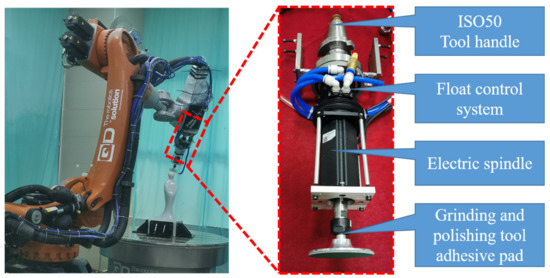
Figure 3.
Robotic processing system.
The workpiece table, driven by a servo motor, allows for rotation and could act as an external axis to the robot system, providing 6+1 axis coordination. The passive floating force controller was used to measure the polishing force and provide feedback to the system. According to the control strategy, the position and orientation of the polishing tool were controlled and adjusted to achieve constant-pressure polishing on the workpiece’s surface, ensuring uniform material removal depth and improving surface quality. This system effectively meets the requirements for flexible polishing of marble with complex curved surfaces.
2.3. Coordinate Measuring Machine (CMM)
In this study, the GLOBAL STATUS 777 Coordinate Measuring Machine from Brown & Sharpe, USA, was used to measure the material removal profile on the surface of the curved marble perpendicular to the feed direction of the polishing pad, as shown in Figure 4. This CMM has a 2 mm-diameter ruby stylus for probing, ensuring a measurement accuracy of 2.5 μm within a measurement space of 700 mm × 700 mm × 700 mm. The measurement parameters adopted in this section were five points per 1 mm of measurement distance.
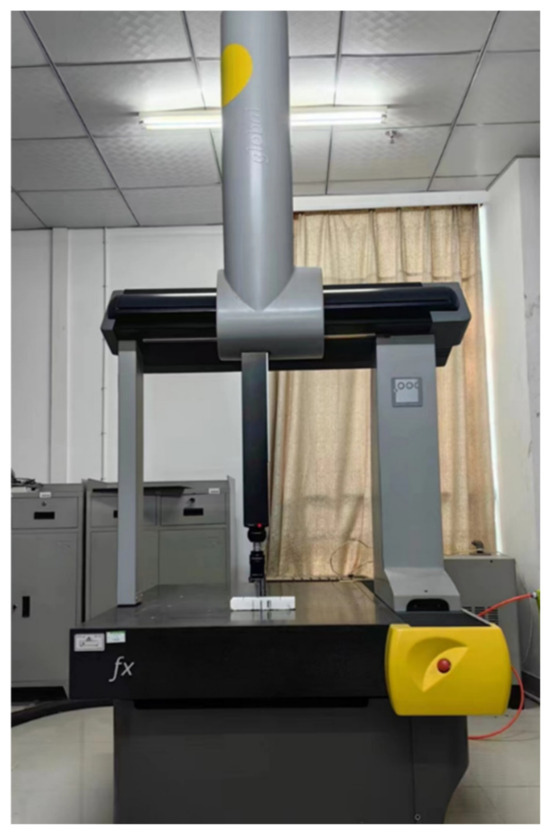
Figure 4.
Material removal profile CMM.
3. Simulation Modeling and Verification
The force applied between the SG flexible tool and the workpiece plays a key role in the amount of material removed during polishing. Surface roughness and gloss are directly influenced by the stability of the polishing force. The fit between the SG flexible tool and the workpiece surface changes as the surface curvature (k) changes. In this section, optimized polishing parameters were used to polish, specifically at a contact angle (θ) of 15° and a contact length (L) of 12.5 mm. CAE software was used to simulate and validate the fitting contact and fitting contact force to ensure that the SG flexible tool achieves constant pressure and efficient polishing with precise position and orientation.
3.1. Creation of a Surface-Fitting Contact Model
A simulation analysis of the contact between the SG flexible tool and the marble surface was carried out using Abaqus, and the contact situation between the SG flexible tool and the marble surface during polishing is shown in Figure 5a,b. In the Abaqus software, a model of the SG flexible tool with identical dimensions was created, assigned the same experimental material properties, and divided into tetrahedral mesh elements. During mesh refinement, the mesh in the contact area was set to 1 mm. Five simulation models were created in the software, each representing a different curvature (k) of the marble surface: 0.004, 0.008, 0.012, 0.016, and 0.02. The free mesh division technique was used with a mesh refinement size of 1 mm in the contact area. The material properties of the marble surface were set based on the properties of Hanbaiyu marble, with a density of 2800 kg/m3, Young’s modulus of 85 GPa, and Poisson’s ratio of 0.28 [33]. In each simulation model, when the SG flexible tool contacted the marble surface, the marble surface was set as the master surface, and the SG flexible tool was identified as the slave surface. The friction coefficient in the contact area between the SG flexible tool and the marble surface was set to 0.
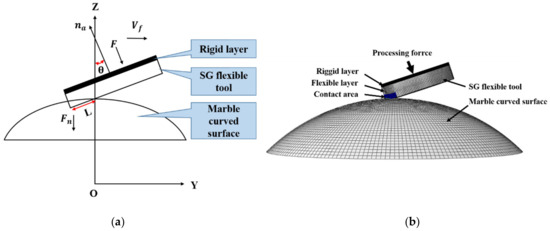
Figure 5.
(a) Schematic diagram of the SG flexible tool in contact with the marble surface. (b) Simulation modeling of the SG flexible tool in contact with the marble surface.
3.1.1. Simulation Analysis of the Fitting Contact Between the SG Flexible Tool and the Surface
When pressure is applied above the SG flexible tool, it causes the SG flexible tool to adhere and contact the curved surface to a certain extent. The degree of adhesion is influenced by changes in the contact angle, applied pressure, and curvature. To accurately analyze the impact of these parameters on the contact area, a simulation analysis was conducted. The simulation results of the contact between the SG flexible tool and marbles with different curvatures are shown in Figure 6. The contact area is leaf-shaped, and its shape varies with changes in curvature and contact angle. The entire contact area consists of the edge arc AHB of the SG flexible tool and the contact arc APB, with the chord height distance PH representing the contact length (L). As shown in Figure 6a, the pressure distribution is generally symmetric along both sides of PH and gradually increases from the center to the edge.
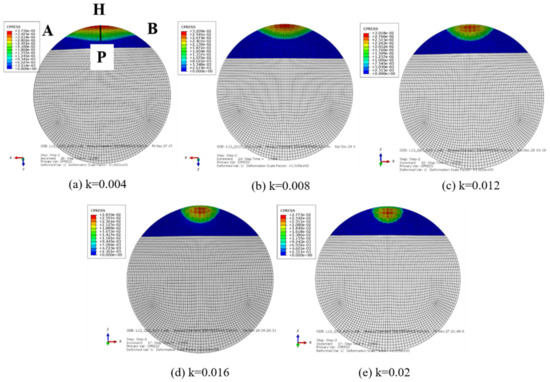
Figure 6.
Simulation of the contact area between the SG flexible tool and the marble surface.
The selection of the contact angle is based on the contact characteristics between the polishing tool and the workpiece surface. During the polishing process, the contact angle determines the contact area and the distribution of contact pressure between the polishing tool and the workpiece surface. Through preliminary experiments and theoretical calculations, it was found that when the contact angle is within a certain range, the contact pressure distribution between the polishing tool and the workpiece surface is relatively uniform, which is conducive to achieving constant-pressure polishing. Therefore, in this study, a contact angle that ensures uniform distribution of contact pressure was selected as the simulation parameter based on extensive preliminary experiments.
The selection of contact length is based on the balance between polishing efficiency and polishing quality. A shorter contact length may lead to low polishing efficiency, while a longer contact length may increase friction and heat during the polishing process, adversely affecting polishing quality. Through extensive preliminary experiments, it was found that maintaining the contact length within a certain range ensures both polishing efficiency and good polishing quality. Therefore, a contact length within this range was selected as the simulation parameter in this study.
In the polishing process, the control of contact angle and contact length is primarily achieved through robot motion trajectory planning and polishing tool posture adjustment. By precisely controlling the robot’s motion trajectory and the polishing tool’s posture, a constant contact angle and contact length can be maintained during the polishing process, thereby achieving constant-pressure polishing.
3.1.2. Analysis of the Fitting Contact Force Between the SG Flexible Tool and the Marble Surface
To maintain a constant contact length (L) when the SG flexible tool is in contact with marble surfaces of different curvature, the polishing force applied to the SG flexible tool differs with each curvature. Following the simulation of the contact area discussed in Section 3.1.1, force was applied to all contact points that were extracted and synthesized to obtain the reactive force of the marble surface on the SG flexible tool. According to the principle of force interaction, the reactive force is also the normal force component of the externally applied force ) on the SG flexible tool. The calculation of the polishing force () required for polishing marble surfaces of different curvatures can be performed using Equation (1).
Variables:
- : denotes the force externally applied to the SG flexible tool.
- : represents the normal component of
- : denotes the contact angle between the SG flexible tool and the workpiece.
Figure 7 shows the relationship between the polishing force (F) and curvature when the marble surfaces of different curvatures are polished with the same contact length (L). The relationship between the polishing force (F) and the curvature of different parameters was fitted, as indicated by the dashed lines in each graph. The R2 values after fitting are consistently close to 1, indicating a high degree of fit.
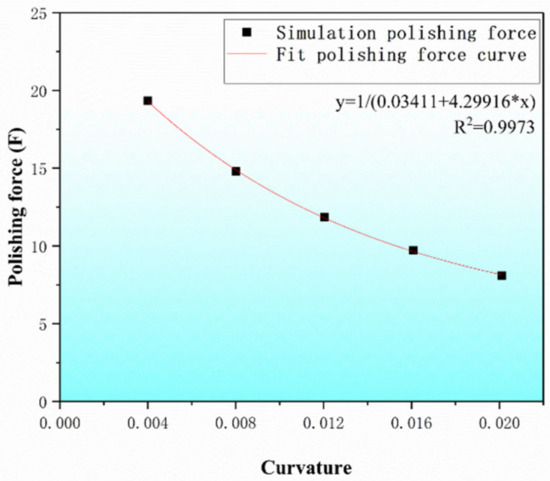
Figure 7.
Simulation of the relationship between the polishing force and different curvatures of the SG flexible tool.
3.1.3. Error Analysis
During the simulation process, although we employed precise modeling and meticulous mesh division, some potential sources of error still exist. Firstly, the material properties set in the Abaqus software are approximate values based on experimental data, such as Young’s modulus and Poisson’s ratio. These parameters may exhibit a certain range of variation in practice, thereby affecting the accuracy of the simulation results. Secondly, although the mesh division is fine, there may still be some errors in the extremely fine structures of the contact area, especially in regions with high curvature. Additionally, environmental factors such as temperature and humidity were not considered in the simulation, which may significantly impact material properties and contact behavior during the actual polishing process.
To quantify these errors, we conducted the following analyses: Firstly, by comparing simulation results under different mesh densities, we found that when the mesh size is smaller than 1 mm, the difference in simulation results is less than 5%. Therefore, the errors caused by mesh division are considered to be within an acceptable range. Secondly, considering the influence of environmental factors, we recommend incorporating these factors in future studies to further enhance the accuracy of the simulations.
3.2. Polishing Trajectory Space Optimization and Planning
There is a difference between using a robot to polish complex curved marble and flat marble. The maximum uniform material removal depth for different curvatures must be consistent to ensure the consistent surface quality of polished marble surfaces of different curvatures. The appropriate polishing trajectory space is determined by simulating fitting contact force and using the Preston Equation. This ensures that when the robot is correctly positioned and oriented, marble with complex curved surfaces can be produced with high consistency.
3.2.1. Simulation of Contact Stress Distribution Between the SG Flexible Tool and the Marble Surface
The simulation of the contact area between the SG flexible tool and marble surfaces of different curvatures was conducted with a specified contact length (L) using Abaqus. It was observed that the contact area was blade-like, and that the pressure in this area increased from the center of the SG flexible tool to the edge, specifically from point P to point H. The pressure was symmetrically distributed along the PH line, as shown in Figure 6a.
The node pressure along the PH path of the contact area between the SG flexible tool and the marble surfaces of different curvatures was obtained from Abaqus and plotted into the node pressure curve, as shown in Figure 8. It can be seen that in the contact areas with different curvature, the pressure along the PH path has an increasing trend and a good linear distribution, especially when the surface curvature is small. However, as the surface curvature increases, there is a tendency for the pressure to decrease near the H point along the PH path. This decrease is mainly due to the reduced contact area between the outer edge of the SG flexible tool and the workpiece as the surface curvature increases, resulting in lower pressure near the edge position. However, the trend can still be considered approximately linear.
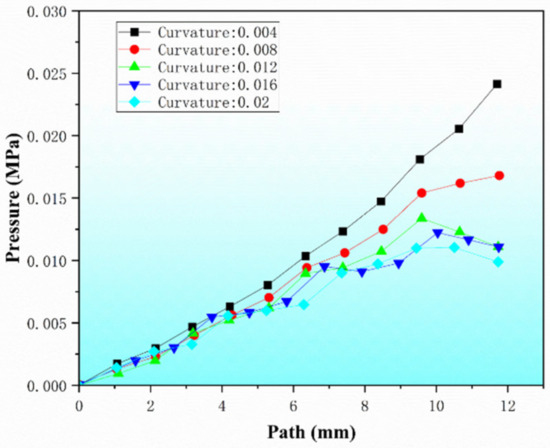
Figure 8.
Node pressure along the PH path direction in the inclined contact region.
3.2.2. Simulation of the Material Removal Profile Under Constant Pressure
To maintain the consistent surface quality of polished marble surfaces of different curvatures, the maximum uniform depth of material removal for different curvatures must be consistent. According to the Preston Equation (Equation (2)), when the contact length is constant and other process parameters remain unchanged, it is essential to ensure a uniform pressure at the center position along the x-axis on the contact surface (PH path in Figure 6a) of marble surfaces of different curvatures.
As shown in Figure 9, the distribution slopes of pressure for each curvature are relatively similar at the specified contact length (L). The average slope of the pressure distribution for each curvature at the contact length (L) is calculated and referred to as the pressure slope (kl) at the contact length (L). Material removal profiles for marble surfaces of different curvatures were simulated with the specified contact length (L) and tilt angle (θ) using MATLAB 2018 b, as shown in Figure 9. It shows that, with a constant contact length (L), the maximum theoretical material removal depth remains relatively constant. Thus, constant-pressure polishing can be achieved by adjusting the polishing force based on surfaces of different curvatures.
Variables:
- : Preston wear coefficient.
- : Contact pressure at the contact point.
- : Relative linear velocity.
- : Dwell time.
- : Material removal depth within the time .
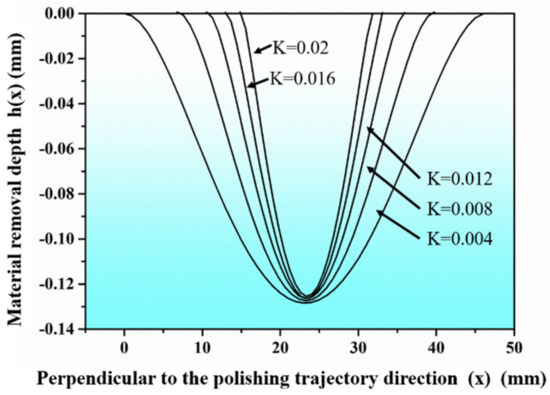
Figure 9.
Theoretical material removal profiles for surfaces of different curvature.
3.2.3. Polishing Trajectory Space Optimization
According to the Preston removal principle, the material removed during polishing represents the cumulative amount at a point on the processed surface over a given period of time. Single-point removal is the cumulative removal in the overlapping region of two adjacent polishing trajectories. Polishing trajectory spaces that are excessively large or overly small can result in uneven material removal depth and poor surface quality.
The analysis suggests that the quality and consistency of the polished surface improve with a smaller peak difference in the material removal profile between the overlapping and non-overlapping regions of the polishing trajectory. This relationship is shown in Figure 10a–c. A curve fit with an R2 value of 0.99736 was obtained by simulating the optimum space for polishing trajectories on surfaces of different curvatures and fitting the data with curvature, as shown in Figure 10d. This high R2 value indicates that this relationship can be used to determine the optimum polishing trajectory space for surfaces of different curvatures in subsequent polishing processes.
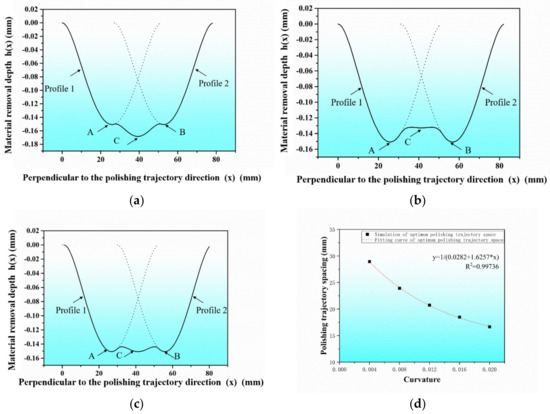
Figure 10.
Selection of polishing trajectory spaces. (a) Overly small polishing trajectory space. (b) Excessively large polishing trajectory space. (c) Optimum polishing trajectory space. (d) Relationship between optimum polishing trajectory space and curvature.
3.2.4. Polishing Trajectory Spacing Optimization Experimental Evaluation and Error Analysis
The theoretical and actual removal profiles under the specified contact length (L) and tilt angle (θ) are shown in Figure 11. It is evident that the experimental profile closely matches the theoretical profile, indicating that the material removal profile during robotic grinding and polishing can be effectively predicted by the theoretical profile.
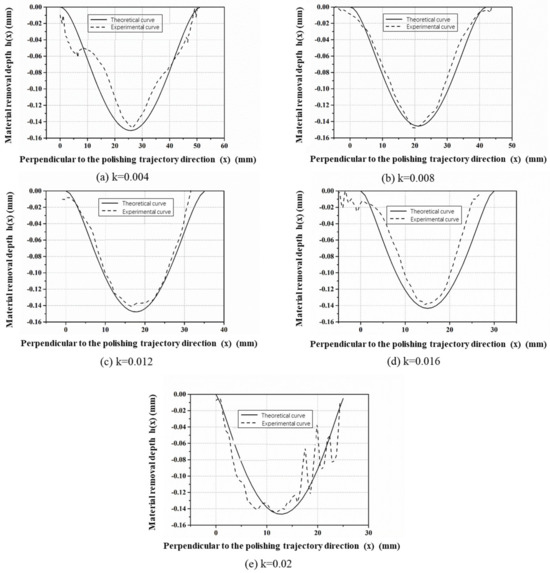
Figure 11.
Theoretical and experimental material removal profiles for surfaces of different curvature.
In the experimental evaluation of polishing trajectory spacing optimization, although we obtained contours that closely matched theoretical predictions, some errors still exist. These errors primarily arise from the following aspects: Firstly, the control of polishing force during the experiment may exhibit certain fluctuations, leading to discrepancies between the actual polishing effect and theoretical predictions. Secondly, the precision and measurement errors of the coordinate measuring machine used during the contour measurement process can also affect the results.
To quantify these errors, we conducted the following analyses: Firstly, by comparing experimental results under different polishing force control strategies, we found that when the polishing force fluctuation is within ±5%, the difference in polishing effects is less than 5%. Secondly, by averaging multiple measurements, we reduced the impact of measurement errors on the results. Nevertheless, it is still recommended to further optimize polishing force control and robot motion precision in future studies to enhance the accuracy of the experiments.
4. Experimental Validation
To fully validate the application of the newly developed SG flexible tool in the robotic polishing of marble with complex curved surfaces, a series of polishing experiments were carried out. The grinding and polishing were continued on the sculptured Han white jade blank. The experiments were divided into three parts:
- (1)
- The first part was to plan and design the processing trajectories.
- (2)
- The second part was to segment the workpiece surfaces of different curvatures based on the force control range and precision of the robotic grinding and polishing system developed in this study.
- (3)
- The third part was to verify the polishing effect achievable by the proposed SG flexible tool using the optimized processing parameters.
4.1. Trajectory Planning
A trajectory planning strategy for the SG flexible tool was developed in Powermill, a commercial CAM software, based on the processing properties of the SG flexible tool in this study. This strategy included linear projection finish machining, reference line embedding, and embedded reference line finish machining, as shown in Figure 12a. According to the optimum trajectory space for surfaces of different curvatures in Figure 11d, the linear projection finish machining strategy was used to allow the tool tip to traverse the 3D model surface. The generated trajectory was then inserted into a newly created reference line and the reference line was embedded into the 3D model surface using the nearest-point method.
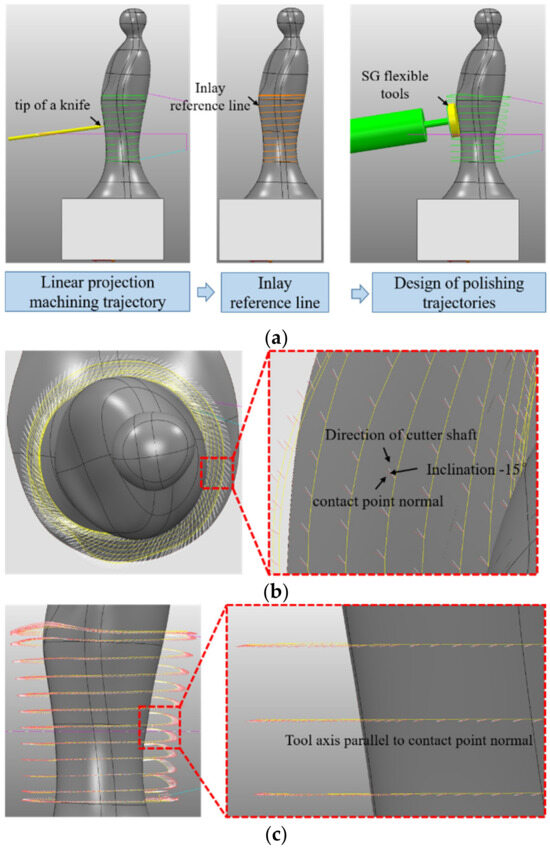
Figure 12.
(a) Planning process for the polishing trajectory of the SG flexible tool. (b) Front angle of the tool axis to the contact normal. (c) Side angle of the tool axis to the contact normal.
The embedded reference line finish machining strategy was applied to plan and design the grinding and polishing trajectory for the SG flexible tool. A five-axis machining strategy was used, with the workpiece rotating. The tool axis and normal surface contact had a front angle of −15°, as shown in Figure 12b, and a side angle of 0°, indicating that the tool axis is parallel to the contact normal, as shown in Figure 12c. The required polishing trajectory was then generated for subsequent grinding and polishing.
4.2. 3D Model of Curvature Partition
To ensure constant-pressure polishing throughout the process, the 3D model of workpiece A was imported into MATLAB, and the surface of the model was partitioned into eight regions: A, B, C, D, E, F, G, and H based on the analysis and calculation of curvature distribution at different regions, as shown in Figure 13. Then, the boundaries of each region were calculated in MATLAB 2018 b, and the boundary point information was integrated into reference lines in Powermill. Finally, the reference lines were embedded into the model surface to serve as boundaries for different regions, as shown in Figure 14. The average curvature values and standard deviations for each region were calculated, as shown in Figure 15.
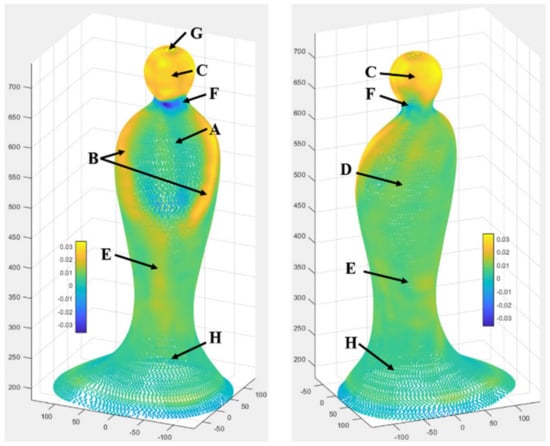
Figure 13.
3D model of curvature partition.
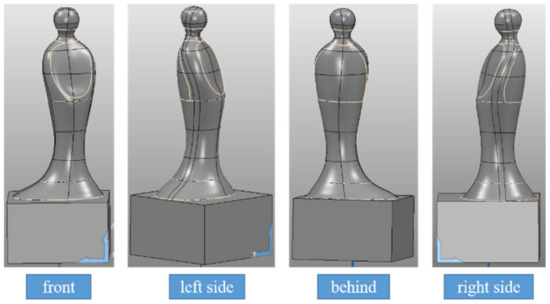
Figure 14.
Boundaries of regions by curvature partition.
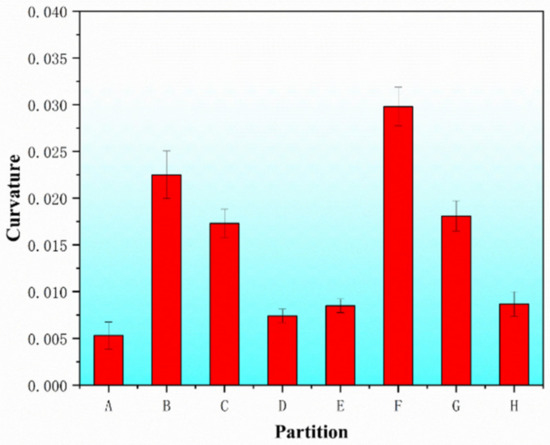
Figure 15.
Curvature distribution of different regions by curvature partition.
4.3. Polishing Experiment Verification
The polishing force (F) and optimum trajectory space in different regions were set to plan the polishing trajectory and process. The field processing is shown in Figure 16, where different regions were polished individually. The polished Han white marble workpiece A, as shown in Figure 17, has various curvature distributions on its surface, with some regions showing significant changes in curvature. However, after grinding and polishing, the overall appearance is smooth, delicate, and uniform, with a remarkable luster effect.
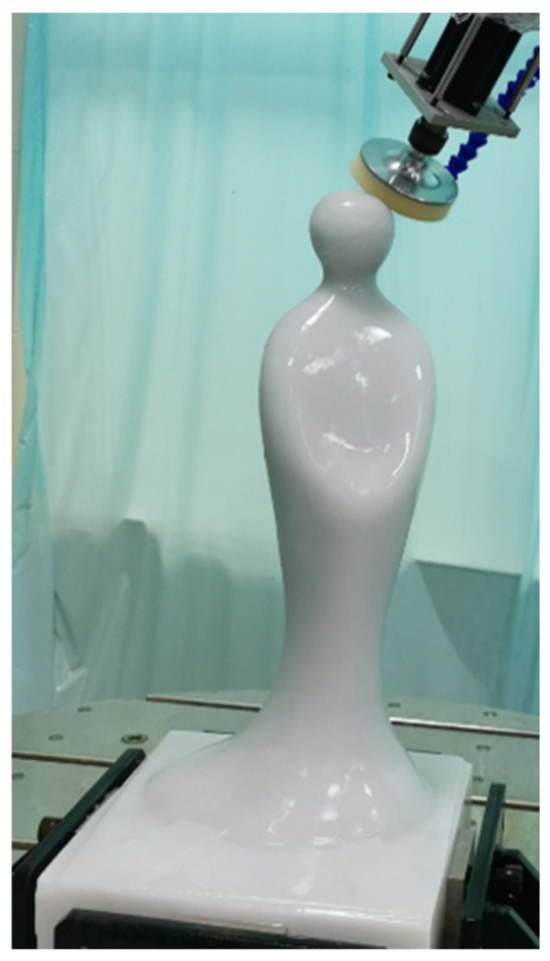
Figure 16.
Flexible polishing of complex-shaped marble.
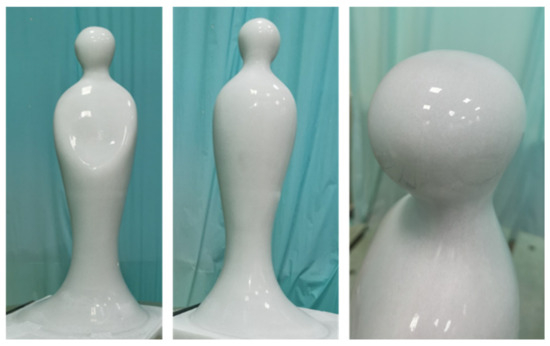
Figure 17.
Workpiece A, polished Hanbaiyu marble.
In this section, the luster effect of workpiece A, polished by the robotic system, is compared with workpiece B, polished by hand, using the text and image reflection method. As shown in Figure 18, the surface of the Han white marble workpiece A, polished by the robotic flexible polishing, effectively reflects the text in the image, maintaining clear text outlines and showing a good mirror effect and consistency. Conversely, Figure 19 shows that the surface gloss of workpiece B, manually polished Han white marble, is significantly inferior to the results of robotic flexible polishing. Although the surface has some gloss, the uniformity and consistency are poor, and the surface is unable to clearly reflect the text and image.
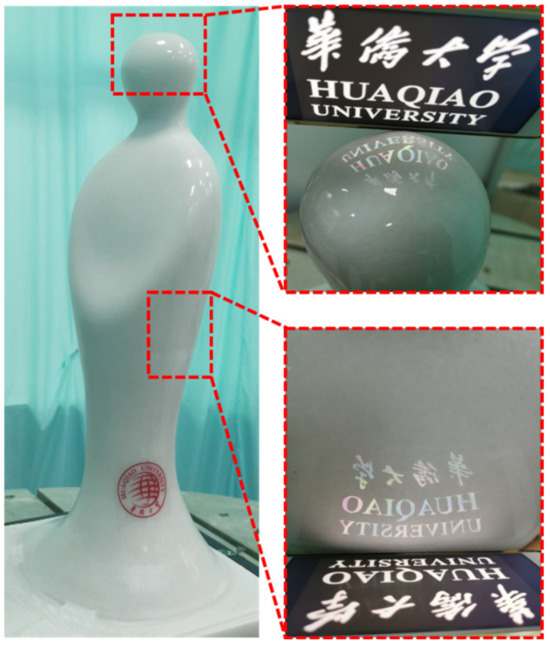
Figure 18.
Surface gloss of workpiece A, robot olished Hanbaiyu marble.
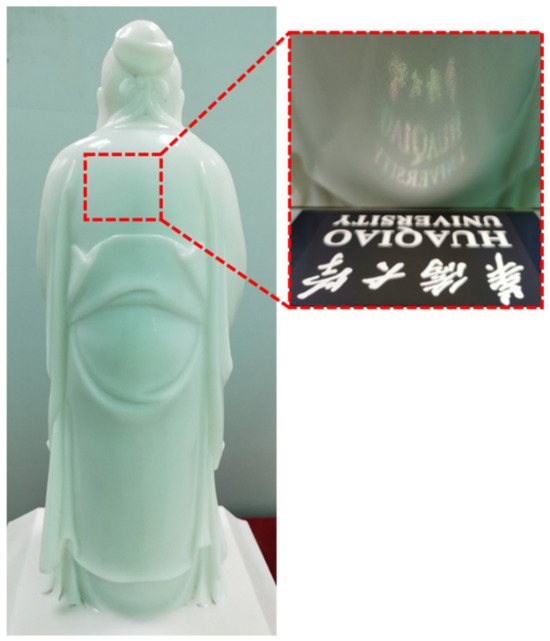
Figure 19.
Surface gloss of workpiece B, hand-polished Hanbaiyu marble.
In this study, roughness (Ra) and glossiness were assessed to evaluate the surface quality of the marble tiles. Roughness was measured with a TIME 3220 portable surface roughness tester. In addition, a WG60G was used to measure the glossiness with a 60° angle for standard measurement. This device has a measurement range from 0 to 2000 gloss units and a resolution of 1 gloss unit. Different regions of the Hanbaiyu marble workpieces polished by the two processing methods were measured for surface roughness and glossiness, as shown in Figure 20. Workpiece B, which was manually polished and waxed, exhibited a surface roughness of 0.2843 μm and a glossiness of only 63.25. The large standard deviations in both measurements indicate poor surface quality and low consistency, suggesting that this polishing method has limited effectiveness in enhancing the surface quality of Hanbaiyu marble workpieces. In contrast, workpiece A, polished by a robot using SG flexible tools, achieved a surface roughness of 0.0233 μm with excellent consistency and a glossiness of 102.5, demonstrating a high level of gloss with minimal variation across different regions. Through a comparative analysis of manual polishing and the SG robotic polishing process in Figure 21, it is evident that adopting robotic processing not only effectively reduces the number of polishing steps but also significantly improves surface quality and consistency. Utilizing SG flexible tools for robotic polishing not only enhances the gloss effect of Hanbaiyu marble workpieces but also further increases their added value.
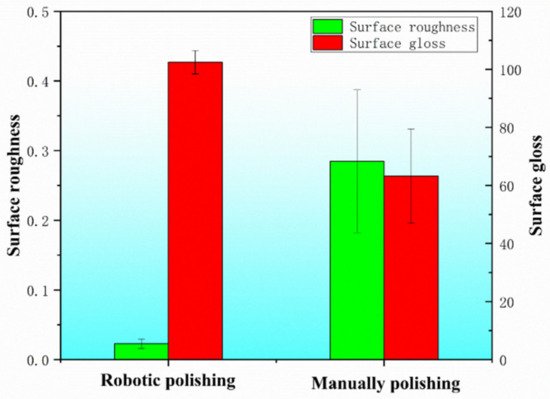
Figure 20.
Surface quality of workpieces after robotic and manual polishing.

Figure 21.
Manual polishing and SG robotic polishing process.
In comparison, the Hanbaiyu marble workpiece A, polished with the SG flexible tool in a robotic polishing system, has a surface roughness of 0.0233 μm and excellent consistency. In addition, it has a high gloss level of 102.5, with minimal differences in gloss between different regions. This indicates that robotic polishing with the SG flexible tool not only achieves a high-quality surface but also ensures good consistency, which effectively improves the gloss of the Hanbaiyu marble workpiece and further increases its added value.
The SG flexible tool after robot flexible polishing shown in Figure 22 only has slight wear. There are no serious deformations or cracks in the prepared SG flexible tool after a long period of storage without any special protective measures. In summary, it can be inferred that the SG flexible tool developed in this study, along with the corresponding procedures and processes, is suitable for robotic flexible polishing of marble with complex curved surfaces.
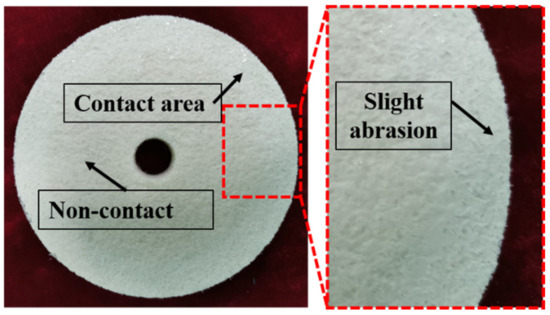
Figure 22.
SG flexible tool after robotic polishing.
4.4. Uncertainty Discussion
During the experimental validation process, although we obtained relatively satisfactory results, some uncertainty factors still exist. Firstly, the wear and distribution changes of abrasive particles during the polishing process may affect the polishing effect, and these factors are difficult to fully control in experiments. Secondly, the inherent material differences and microstructures of marble can significantly impact the polishing effect, causing marble from different batches to exhibit varying levels of glossiness and roughness under the same polishing conditions. Additionally, environmental factors such as temperature and humidity during the experimental process may also influence the polishing outcomes to some extent.
To mitigate the impact of these uncertainty factors, we implemented the following measures: Firstly, before each experiment, we carefully inspected the SG flexible tool to ensure uniform distribution of abrasive particles and the absence of significant wear. Secondly, we selected marble with similar material properties and consistent microstructures for the experiments to reduce the influence of material differences on the results. Lastly, we maintained constant temperature and humidity conditions during the experiments to minimize the effects of environmental factors on the polishing outcomes. Despite these measures, it is still recommended to further explore the specific impacts of these factors on the polishing effect in future research and seek more effective control methods.
4.5. Discussion
This paper addresses the issue of polishing the complex curved surfaces of marble by proposing a robotic polishing solution based on the SG flexible tool, achieving high-quality polishing of intricate marble surfaces. This study establishes a material removal function model for the polishing process, optimizes the polishing trajectory spacing, and develops a relationship model between the optimal polishing trajectory spacing and curvature for different curved surfaces. Experimental validation demonstrates that this solution not only significantly reduces surface roughness but also greatly enhances surface gloss, with good consistency in surface quality after polishing. Compared to traditional manual polishing, robotic flexible polishing not only improves production efficiency and reduces potential health hazards to workers but also significantly enhances the final quality and added value of the products. This research not only provides an effective solution for the automated polishing of complex curved marble surfaces but also offers new insights into the intelligent development of the stone processing industry. In the future, with continuous advancements in robotic technology and polishing processes, it is believed that this field will witness more innovations and breakthroughs.
5. Conclusions
In this paper, the robotic polishing process of marble with complex curved surfaces based on SG flexible tools was investigated and polishing experiments on Hanbaiyu marble workpieces were conducted. The main conclusions are as follows:
- (1)
- In this paper, SG flexible tools were manufactured based on SG flexible polishing film and flexible fiber. When the diamond abrasive grains are in contact with the marble, the SG flexible polishing film yields at a micro level and the flexible fiber layer yields at a macro level to achieve double yielding at both the micro and macro levels so that the SG flexible tools can better fit to the complex curved surface.
- (2)
- The relationship between surfaces of different curvatures and polishing forces was built by simulating the contact of the SG flexible tool. Based on the Preston material removal theory, the complex contact force distribution between the SG flexible tool and the marble, as well as the constant-pressure material removal contour, were simulated to achieve constant-pressure polishing of surfaces of different curvature, which ensures consistency of the polished surfaces.
- (3)
- When SG flexible tools are used to grind and polish marble surfaces of different curvature, the optimum polishing trajectory space and the curvature of curved marble can be well matched to a curvilinear model, which can be used to guide the actual machining.
- (4)
- The polishing of the Hanbaiyu marble workpieces demonstrates that by using the SG flexible tool developed in this study in robotic polishing of marble with complex curved surfaces, we can obtain a polished marble with both good surface quality and high consistency, which effectively improves the quality of the products and further increases their added value. This also validates the high consistency of the surfaces after polishing with the optimized trajectory space.
In summary, this paper presents a study on the robotic polishing process of complex curved marble surfaces based on the SG flexible tool, providing new ideas and methods for the intelligent development of the stone processing industry. Future work will continue to delve into the issues of errors and uncertainties in the polishing process, further refining polishing methods and techniques to make greater contributions to the sustainable development of the stone processing industry.
Author Contributions
Conceptualization, S.H. and J.L.; Methodology, F.Y. and J.L.; Validation, S.H. and J.L.; Formal analysis, J.H.; Writing—original draft, Y.G.; Writing—review & editing, S.H., Y.G. and J.H.; Visualization, Y.G.; Project administration, S.H. and F.Y.; Funding acquisition, S.H. and F.Y. All authors have read and agreed to the published version of the manuscript.
Funding
This research received no external funding.
Institutional Review Board Statement
Not applicable.
Informed Consent Statement
Not applicable.
Data Availability Statement
The original contributions presented in this study are included in the article. Further inquiries can be directed to the corresponding author.
Acknowledgments
The authors appreciate the financial support from Fujian Science and Technology Project (Grant No. 2022H0018, 2022H6029).
Conflicts of Interest
The authors declare no conflict of interest.
References
- Luo, G. Study on the characteristics of new stone grinding and polishing. Mod. Manuf. Technol. Equip. 2019, 06, 13–14. [Google Scholar] [CrossRef]
- Cevheroğlu, Ç.S.; Dağ, A.; Karakuş, A. Application of response surface methodology and central composite inscribed design for modeling and optimization of marble surface quality. Adv. Mater. Sci. Eng. 2016, 2016, 2349476. [Google Scholar] [CrossRef]
- Gürcan, S.; Goktan, R.M.; Yildiz, A. Effect of mineralogical and microstructural properties on surface roughness and gloss of some ornamental marbles subjected to polishing process. X-Ray Spectrom. 2014, 43, 70–78. [Google Scholar] [CrossRef]
- Jin, M.S. Gasbag Polishing Mechanism and Process on Free-Form Surface Mould. Ph.D. Thesis, Zhejiang University of Technology, Hangzhou, China, 2009. [Google Scholar]
- Doukas, C.; Pandremenos, J.; Stavropoulos, P.; Foteinopoulos, P.; Chryssolouris, G. On an empirical investigation of the structural behavior of robots. Procedia CIRP 2012, 3, 501–506. [Google Scholar] [CrossRef][Green Version]
- Kalt, E.; Monfared, R.; Jackson, M.R. Towards an automated polishing system: Capturing manual polishing operations. Int. J. Res. Eng. Technol. 2016, 5, 182–192. [Google Scholar] [CrossRef]
- Nascimento, A.S.B.D.; Sousa, F.J.P. Distribution of contact pressure over the surface of ceramic floor tiles during the polishing process. J. Eur. Ceram. Soc. 2014, 34, 3209–3215. [Google Scholar] [CrossRef]
- Jin, M.S.; Wang, L.M.; Ye, S.B.; Qi, H.; Kang, J.; Hong, T.; Fang, Z.F.; Dong, X.X. A novel functionally graded lapping and polishing method for the improvement of material removal uniformity. J. Manuf. Process. 2020, 50, 102–110. [Google Scholar] [CrossRef]
- Yavuz, H.; Ozkahraman, T.; Demirdag, S. Polishing experiments on surface quality of building stone tiles. Constr. Build. Mater. 2011, 25, 1707–1711. [Google Scholar] [CrossRef]
- Huang, S.G.; Lu, J.; Chen, S.H.; Huang, H.; Xu, X.P.; Cui, C.C. Study on the surface quality of marble tiles polished with Sol-Gel derived pads. J. Sol-Gel Sci. Technol. 2019, 91, 485–495. [Google Scholar] [CrossRef]
- Zhang, Z.M.; Zhang, J.S.; Gao, S.; Lu, C.R.; Zheng, C.Y. Experimental Study on Relation between Tool Wear and Grinding Force for Shaping Diamond Tool. Adv. Mater. Res. 2010, 97, 1925–1928. [Google Scholar] [CrossRef]
- Tawakoli, T.; Reinecke, H.; Vesali, A. An Experimental Study on the Dynamic Behavior of Grinding Wheels in High Efficiency Deep Grinding. Procedia CIRP 2012, 1, 382–387. [Google Scholar] [CrossRef]
- Zhu, D.H.; Feng, X.Z.; Xu, X.H.; Yang, Z.Y.; Li, W.L.; Yan, S.J.; Ding, H. Robotic grinding of complex components: A step towards efficient and intelligent machining—Challenges, solutions, and applications. Robot. Comput. Integr. Manuf. 2020, 65, 101908. [Google Scholar] [CrossRef]
- Mohammad, A.E.K.; Wang, D.W. A novel mechatronics design of an electrochemical mechanical end-effector for robotic-based surface polishing. In Proceedings of the 2015 IEEE/SICE International Symposium on System Integration (SII), Nagoya, Japan, 11–13 December 2015; pp. 127–133. [Google Scholar] [CrossRef]
- Xie, T.X.; Jin, X.Y.; Jiang, M.H. Optimal Trajectory Planning of Flexible Polishing Industrial Robot Based on Genetic Algorithm. Modul. Mach. Tool Autom. 2020, 6, 47–49, 53. [Google Scholar] [CrossRef]
- Chen, Z.T.; He, Z.Q.; Wang, K.C. Research on polishing process of flexible polishing wheel. Mach. Des. Manuf. 2019, 12, 109–111, 116. [Google Scholar] [CrossRef]
- Tan, Z.; Yu, W.D.; Chen, J.W.; Jiang, X. Design and Simulation of Flexible Polishing Tool Device. Intern. Combust. Engine Parts 2019, 2, 56–59. [Google Scholar] [CrossRef]
- Pilný, L.; Bissacco, G. Development of on the machine process monitoring and control strategy in Robot Assisted Polishing. CIRP Ann. 2015, 64, 313–316. [Google Scholar] [CrossRef]
- Xiao, G.J.; Huang, Y.; Yin, J.C. An integrated polishing method for compressor blade surfaces. Int. J. Adv. Manuf. Technol. 2017, 88, 1723–1733. [Google Scholar] [CrossRef]
- Zhu, D.H.; Xu, X.H.; Yang, Z.Y.; Zhuang, K.J.; Yan, S.J.; Ding, H. Analysis and assessment of roboticbelt grinding mechanisms by force modeling andforce control experiments. Tribol. Int. 2018, 120, 93–98. [Google Scholar] [CrossRef]
- Lv, Y.J.; Peng, Z.; Qu, C.; Zhu, D.H. An adaptive trajectory planning algorithm for robotic belt grinding of blade leading and trailing edges based on material removal profile model. Robot. Comput.-Integr. Manuf. 2020, 66, 101987. [Google Scholar] [CrossRef]
- Wahballa, H.; Duan, J.J.; Dai, Z.D. Constant force tracking using online stiffness and reverse damping force of variable impedance controller for robotic polishing. Int. J. Adv. Manuf. Technol. 2022, 121, 5855–5872. [Google Scholar] [CrossRef]
- Duan, J.J.; Gan, Y.H.; Chen, M.; Dai, X.Z. Adaptive variable impedance control for dynamic contact force tracking in uncertain environment. Robot. Auton. Syst. 2018, 102, 54–65. [Google Scholar] [CrossRef]
- Wang, T.; Zhao, H.; Xie, Q.L.; Li, X.F.; Ding, H. A Path Planning Method Under Constant Contact Force for Robotic Belt Grinding. In Intelligent Robotics and Applications, Proceedings of the 12th International Conference, ICIRA 2019, Shenyang, China, 8–11 August 2019; Part VI 12; Springer International Publishing: Cham, Switzerland, 2019; pp. 35–49. [Google Scholar] [CrossRef]
- Zhang, J.; Wang, H.; Senthil, K.A.; Jin, M.S. Experimental and theoretical study of internal finishing by a novel magnetically driven polishing tool. Int. J. Mach. Tools Manuf. 2020, 153, 103552. [Google Scholar] [CrossRef]
- Wang, Q.H.; Xie, L.J.; Xu, C.Y.; Chen, R.Q.; Zhou, X.F. Material removal modeling and trochoidal toolpath control for surface polishing. J. South China Univ. Technol. (Nat. Sci. Ed.) 2018, 46, 8–15. [Google Scholar] [CrossRef]
- Xie, L.J. Tool Contact State Analysis and Multi Directional Trajectory Process Control of Robotic Surface Polishing. Master’s Thesis, South China University of Technology, Guangzhou, China, 2018. [Google Scholar]
- Huang, T. Research on Robot Grinding and Polishing Method based on Passive Compliance Control. Doctoral Thesis, Soochow University, Suzhou, China, 2017. [Google Scholar]
- Han, G.C.; Zhang, H.O.; Wang, G.L.; Ren, J. Experimental study on the robotic polishing process with dissociating abrasive. China Mech. Eng. 2007, 18, 2152–2155. [Google Scholar] [CrossRef]
- Coelho, A.; Pereira, J.C.G.; Amaral, P.M.; Rosa, L.G. Gloss and Modelling Studies of Stone Polishing Using Linear Polishing Machines with Rotating Heads. Appl. Sci. 2022, 12, 7521. [Google Scholar] [CrossRef]
- Xu, Y.C.; Lu, J.; Xu, X.P.; Chen, C.C.A.; Lin, Y.J. Study on high efficient sapphire wafer processing by coupling SG-mechanical polishing and GLA-CMP. Int. J. Mach. Tools Manuf. 2018, 130–131, 12–19. [Google Scholar] [CrossRef]
- Naji-Tabasi, S.; Shahidi-Noghabi, M.; Dovom, A.M. Investigating the fabrication and functional properties of new composite hydrogels containing gellan/alginate/xanthan gum. J. Sol-Gel Sci. Technol. 2023, 105, 637–649. [Google Scholar] [CrossRef]
- Liu, S.Y.; Wang, F.Z.; Guo, Z.Y.; Yin, F.C. Simulation of high-speed scratching process of marble based on finite element/discrete element coupling method. Diam. Abras. Eng. 2019, 39, 95–100. [Google Scholar] [CrossRef]
Disclaimer/Publisher’s Note: The statements, opinions and data contained in all publications are solely those of the individual author(s) and contributor(s) and not of MDPI and/or the editor(s). MDPI and/or the editor(s) disclaim responsibility for any injury to people or property resulting from any ideas, methods, instructions or products referred to in the content. |
© 2024 by the authors. Licensee MDPI, Basel, Switzerland. This article is an open access article distributed under the terms and conditions of the Creative Commons Attribution (CC BY) license (https://creativecommons.org/licenses/by/4.0/).